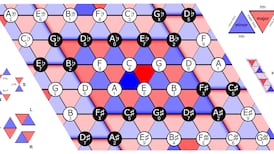UNDER THE MICROSCOPE:As well as providing a chunk of our RDA of vitamins, bananas are a staple crop for millions of farmers
THE BANANA IS possibly the most popular of all fruits. Bananas are grown throughout the tropics, where they are a major source of food and a major source of income for smallholder farmers.
Banana is the common name for the tree-like herb of the genus Musa, family Musaceae. They are cultivated mainly for their fruit and, to a lesser extent, for the production of fibre. The banana is a large herb with a perennial root (rhizome), from which the plant is perpetuated by sprouts (suckers). The banana plants are often mistaken for trees, because the main stems are tall and upright, reaching heights of two to eight metres. Each stem produces a bunch of bananas, then dies down and is replaced by another stem.
The fruit grows in hanging clusters, with up to 20 fruits to a hand (what we call a bunch), and three to 20 hands in the cluster. The total weight of the hanging clusters on a stem can weigh from 30-50kg. Each fruit varies in length from 10 to 30cm and weighs about 175 grams. About 75 per cent of the fruit is water and 25 per cent is dry matter. Bananas are quite nutritious and a typical banana has about the same number of calories as a potato. A 100 gram banana contains 22.8 grams of carbohydrate (including 2.6 grams of dietary fibre), 1.1 grams of protein, 0.33 grams of fat, and will supply the following percentages of the recommended daily intake of vitamins and minerals: vitamin B6 (28 per cent), vitamin C (15 per cent), vitamin B5 (7 per cent), vitamin B9 (5 per cent), vitamin B3 (4 per cent), vitamin B1 (2 per cent), potassium (8 per cent), magnesium (7 per cent), iron (2 per cent), phosphorous (3 per cent), calcium (1 per cent) and zinc (1 per cent).
A banana is far more nutritious than an apple, having considerably more protein, carbohydrate, vitamins and minerals. Bananas are highly recommended by doctors for patients whose potassium is low and are also popular with people who want to reduce sodium in their diet (bananas have very little sodium).
Bananas are recommended as being useful in the following medical conditions: anaemia (bananas are high in iron); blood pressure (bananas are high in potassium, but low in sodium or salt); constipation (bananas are high in fibre); heartburn (bananas have an antacid effect); nerves (high vitamin B levels calm the nervous system); seasonal affective disorder and depression (bananas contain the natural mood enhancer tryptophane); strokes (bananas reduce the risk of stroke); ulcers (they can be eaten without distress in severe ulcer cases); and hangovers (take a banana milkshake, sweetened with honey).
Plantains (M paradisiacal) are cooking bananas and are larger, coarser and less sweet than the kinds of banana that are eaten raw. Bananas and plantains are a major staple food crop in developing countries. Bananas and plantains produce fruit throughout the year and are therefore very valuable during the "hunger season", ie the time when food from seasonal harvests has been eaten and the next harvest is some time away. Cooking bananas are used like potatoes - they can be boiled, baked, fried or chipped.
India led the world in banana production in 2003, producing about 23 per cent of the worldwide crop. In the top-10 banana producers, India was followed in order by Brazil, China, Ecuador, Philippines, Indonesia, Costa Rica, Mexico, Thailand, Columbia and Burundi.
The familiar banana on our supermarket shelves is the ripe dessert banana. It is available fresh all year because the banana is a non-seasonal crop. By far the most important variety of dessert banana is the Cavendish. The Cavendish replaced the previous favourite, called Gros Michel, in the 1950s, when Gros Michel became very susceptible to Panama disease, a fungus that attacks the roots of the banana plant.
Bananas for export are usually picked green and ripened in ripening rooms when they reach their country of destination. The ripening rooms are filled with ethylene gas to induce ripening. Bananas allowed to ripen naturally have richer flavour.
Most banana farmers receive low prices for the produce they export because supermarkets buy the bulk of the bananas, receive large discounts, and competition between supermarkets has led to even lower prices for growers.
In popular parlance, the term "banana skin" refers to a hidden trap awaiting the unwary. The term "banana republic" is often used in a pejorative sense, meaning a small, tropical country dependent on basic agriculture, politically unstable, often ruled by a self-elected wealthy elite, and with the mass of the people poorly paid and educated. The term was coined by the American humorist, O Henry, in reference to Honduras.
Bob Geldof wrote a song called Banana Republic. The title refers to Ireland and Geldof wrote the song to express his anger after his band, the Boomtown Rats, had been refused permission to hold a concert in Ireland.
William Reville is associate professor of biochemistry and public awareness of science officer at UCC. http://understandingscience.ucc.ie










